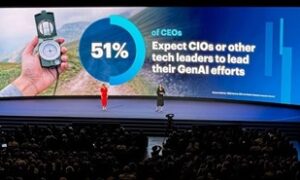
Artificial intelligence (AI), and the emergence of generative AI (GenAI), are shifting how humans and machines interact, and this is resulting in two key focus areas for CIOs as AI becomes an enterprise initiative, not just an IT initiative, according to Gartner, Inc.
“GenAI is not just a technology or just a business trend. It is a profound shift in how humans and machines interact,” said Mary Mesaglio, Distinguished VP Analyst at Gartner.
“We are moving from what machines can do for us to what machines can be for us.”
“Machines are evolving from being our tools to becoming our teammates,” said Gabriela Vogel, Sr Director Analyst, at Gartner. “Gartner predicts that by 2025, GenAI will be a workforce partner for 90% of companies worldwide.”
Vogel added that CIOs have a major role in how they shape AI and how AI shapes us. According to recent Gartner surveys of CEOs, CIOs are their number one choice to unlock the value of GenAI.”
During the opening keynote of Gartner IT Symposium/Xpo, which took place recently in Barcelona, Gartner analysts told the audience of over 6,500 CIOs and IT executives to prioritise two areas to unleash the possibility of AI over the next 12-24 months – decide their AI Ambition and become AI-Ready.
Decide Your AI Ambition – there are two flavours of AI:
● Everyday AI is focused on productivity. The machine is a productivity partner. It enables workers to do what they already do faster and more efficiently. Currently, 75% of EMEA CIOs and technology leaders are focused on the opportunities of everyday AI. “It is important to note that everyday AI will go from dazzling to ordinary with outrageous speed,” said Mesaglio. “Everyone will have access to the same tools, and it will not provide a sustainable competitive advantage. Everyday AI is the new table stakes.”
● Game-changing AI is focused primarily on creativity. “It doesn’t just make us faster or better. Either it creates new results, via AI-enabled products and services; or it creates new ways to create new results, such as with AI-enabled new core capabilities. With game-changing AI, machines will disrupt business models and entire industries,” said Mesaglio.
“More and more AI will be jointly delivered by IT and the wider enterprise,” said Vogel. “To succeed, the whole executive team must be engaged. This provides a tremendous opportunity for CIOs to make a difference.”
CIOs can help their CEO and CxO peers cut through AI complexity and define their organisation’s AI ambition by examining the opportunities and risks of using GenAI in four areas: the back office, the front office, new products and services, and new core capabilities.
As AI continues transforming the relationship between humans and machines, CIOs must actively shape the nature of this change. In this new era of human-machine interaction, there will be many unforeseen consequences.”
“A technology decision is not just a technology decision anymore. It is a technology, economic, social and ethical decision all at once,” said Mesaglio. “To navigate decisions about AI in their organisation, CIOs and IT leaders need lighthouse principles — a vision for AI that lights the way and says what kind of human-machine relationships they will and will not accept.”
However, few organisations have established lighthouse principles or even a clear vision for AI. A Gartner survey in June 2023 of 606 CIOs and technology leaders found that only 9% of organisations have an AI vision statement in place, and more than one-third of respondents had no plans to create an AI vision statement.
Three key strategy to swift and safe adoption
● Establish AI-ready principles: Lighthouse principles must align with the values of the organisation. The organisation’s values must be the guiding light for navigating the unknowns of how humans and machines will interact.
● Make data AI-ready: For data to be AI-ready, it must meet five criteria. It is secure, enriched, fair, accurate and is governed by the lighthouse principles.
● Implement AI-ready security: For every positive use of AI, someone is putting that same technology to negative use. This is the dark side of AI. CIOs should prepare for new attack vectors and work with the executive team to create an acceptable use policy for public generative AI solutions.
“The era of AI-powered business will lead to unintended consequences without advance planning. CIOs need a way to light the way forward, even when everything seems new or murky,” said Mesaglio. “To safely harness this disruption, CIOs must work with executive leaders to define their ambitions for using everyday AI and game-changing AI, and to establish AI-ready principles, data and security.”











